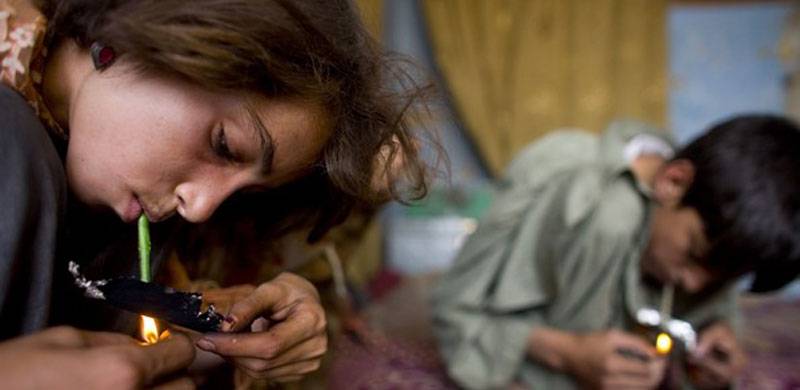
Drug addiction is an inability to control or regulate drug intake causing mental breakdowns, anxiety and depression. It harms a person physically but also affects brain and behaviour. Pakistan is fighting against out-of-control drug use and trying to figure out possible solutions like youth rehabilitation centres and awareness campaigns through advertisements to get rid of this disease.
As per a 2013 report on drugs by the United Nations Office on Drugs and Crime (UNODC), almost 6.7 million people are taking drugs in Pakistan. The report also revealed that people from age 15 to 64 use prescription drugs for non-medical purposes. This is an alarming problem in the country since the youth of Pakistan is suffering from substance abuse disorder (SUD) for which there are many reasons including communication gap between families and mental health disorders.
Drug addiction can start with experimental use of a recreational drug in social situations which can later turn into drug addiction. For others, specifically with opioids, drug dependency starts with prescribed medications, or through acquiring medicinal drugs from a pal or relative who has been prescribed the medication.
According to the United Nations Office on Drugs and Crime of more than 6.7 million people who use drugs in Pakistan about 4 million are addicts, which is amongst the higher ratio of any country in the world. Drug consumption increases significantly during times of transition. For adults, a divorce or loss of a job may also increase the chance of drug use. For a youngster, risky instances include moving or changing schools. When kids move from elementary to middle school they face new and tough social, familial and academic conditions. Frequently throughout this period children are exposed to substances such as cigarettes and alcohol for the first time. While people leave high school and become more independent, either in college or as an employed person, they'll be exposed to drug use while separated from the protective structure supplied by family and school.
The use of illicit pills and the non-clinical use of prescription drugs are established phenomena in Pakistan. The difficulty of curtailing non-medical use of pharmaceuticals has always remained a challenge for health administrators. The National Ministry of Health Reforms and Provincial Health Departments never undertake any scientific study or research to become aware of the gravity of the non-scientific use of pharmaceuticals, and its consequences.
According to a report published by DAWN, between 15 to 35 people end their lives in Pakistan every day. That's as high as one person every hour. The World Health Organisation (WHO) estimated that in 2012 the rate of suicide in Pakistan was 7.5 per 100,000 people. In other words, around 13,000 people killed themselves that year. In 2016 the estimate was 2.9 per 100,000 i.e. over 5,500 ended their lives. Experts say the number of people dying is likely somewhere between the two figures, but the truth remains hidden.
As per a 2013 report on drugs by the United Nations Office on Drugs and Crime (UNODC), almost 6.7 million people are taking drugs in Pakistan. The report also revealed that people from age 15 to 64 use prescription drugs for non-medical purposes. This is an alarming problem in the country since the youth of Pakistan is suffering from substance abuse disorder (SUD) for which there are many reasons including communication gap between families and mental health disorders.
Drug addiction can start with experimental use of a recreational drug in social situations which can later turn into drug addiction. For others, specifically with opioids, drug dependency starts with prescribed medications, or through acquiring medicinal drugs from a pal or relative who has been prescribed the medication.
According to the United Nations Office on Drugs and Crime of more than 6.7 million people who use drugs in Pakistan about 4 million are addicts, which is amongst the higher ratio of any country in the world. Drug consumption increases significantly during times of transition. For adults, a divorce or loss of a job may also increase the chance of drug use. For a youngster, risky instances include moving or changing schools. When kids move from elementary to middle school they face new and tough social, familial and academic conditions. Frequently throughout this period children are exposed to substances such as cigarettes and alcohol for the first time. While people leave high school and become more independent, either in college or as an employed person, they'll be exposed to drug use while separated from the protective structure supplied by family and school.
The use of illicit pills and the non-clinical use of prescription drugs are established phenomena in Pakistan. The difficulty of curtailing non-medical use of pharmaceuticals has always remained a challenge for health administrators. The National Ministry of Health Reforms and Provincial Health Departments never undertake any scientific study or research to become aware of the gravity of the non-scientific use of pharmaceuticals, and its consequences.
According to a report published by DAWN, between 15 to 35 people end their lives in Pakistan every day. That's as high as one person every hour. The World Health Organisation (WHO) estimated that in 2012 the rate of suicide in Pakistan was 7.5 per 100,000 people. In other words, around 13,000 people killed themselves that year. In 2016 the estimate was 2.9 per 100,000 i.e. over 5,500 ended their lives. Experts say the number of people dying is likely somewhere between the two figures, but the truth remains hidden.
